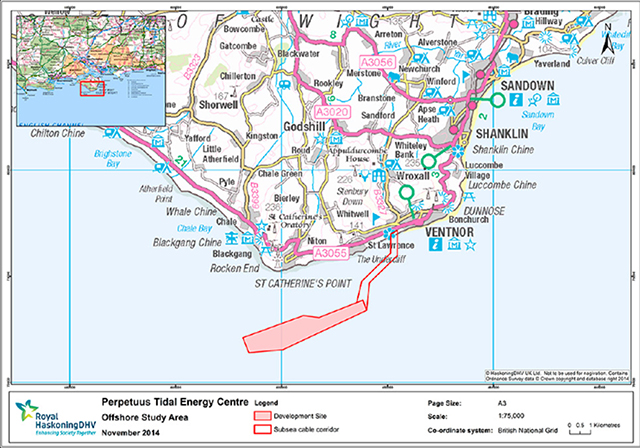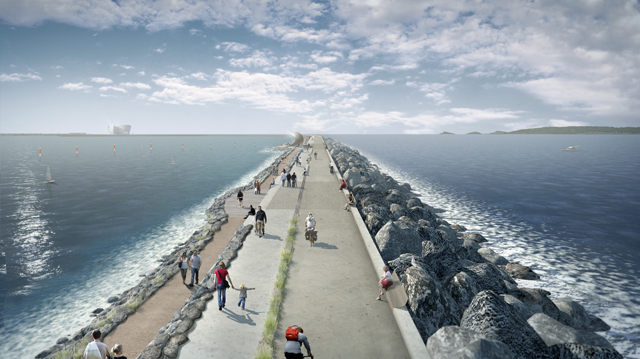Charles Hendry urges ministers to approve plans, which could provide the UK with reliable and clean electricity
Plans for a £1.3billion tidal lagoon in Swansea Bay have been backed by a government-commissioned review.
Charles Hendry, a former energy minister, said his independent review of tidal power had concluded a small trial lagoon at Swansea Bay was a “no regrets option” that could open the way to at least five other full-scale projects around the UK.
Harnessing tidal power
The company Tidal Lagoon Power, which has proposed the project for Swansea, has already spent £35million on the south-west Wales lagoon. It said that if a subsidy deal could be agreed with the government construction could start next year and provide 2,000 jobs.
The company wants to build a U-shaped breakwater across the city’s bay and use the incoming and outgoing tides to turn a bank of 16 hydro turbines in the breakwater to generate enough electricity for 150,000 homes.
The UK government still needs to agree on a deal and a marine licence would also need to be approved.
Mr Hendry said moving ahead with a pathfinder lagoon off the Swansea coast should be seen as a “no regrets” policy.
There are hopes of developing a network of larger lagoons around the UK coast, harnessing power from the ebb and flow of the sea’s tides.
But Mr Hendry believed that was “too ambitious a goal” before even one had been built and “could only be considered properly when more progress had been made.”

Swansea Bay Tidal Lagoon artist impression
Report findings
The report makes over 30 recommendations for delivering a tidal lagoon industry bringing maximum benefit to the UK. It also notes the overwhelming support the project has in Swansea Bay. The conclusions include:
- The technology would “contribute positively” towards the UK’s decarbonisation goals
- It was “beyond question” that local economic regeneration would follow a tidal lagoon
- It offers “significant economic opportunity” for Wales and the UK
- The potential impact on consumer bills of large scale tidal lagoons “appears attractive, particularly when compared to nuclear projects” in the long term
- A high level of monitoring of environmental impacts would still be needed
- A Tidal Power Authority should oversee the new industry
- Competitive tendering for future projects “to deliver the most substantial cost reductions” – similar to the nuclear industry
Mr Hendry and his review team have been gathering evidence for nearly a year for his independent inquiry, visiting Swansea, Cardiff, Newport, Liverpool, Bristol and Sheffield.
This enabled him to speak directly to people who would be involved in, or affected by proposals for tidal lagoons. The Review received almost 200 responses to the Call for Evidence.
Mr Hendry said: ‘If you look at the cost spread out over the entire lifetime – 120 years for the project – it comes out at about 30p per household for the next 30 years. That’s less than a pint of milk.
‘That’s where I think we can start a new industry and we can do it at an affordable cost to consumers.’
Looking to the future

Tidal Lagoon Swansea Bay Project
The Swansea Bay project would involve 16 turbines along a breakwater but is seen as only the start – a prototype for much larger lagoons.
The “fleet” includes one off the coast of Cardiff – east of where Cardiff Bay is now – Newport, Bridgwater Bay in Somerset, Colwyn Bay and west Cumbria, north of Workington.
Tidal energy plans for Swansea Bay first emerged in 2003 but the current project has been developed over the last four years.
But there are still environmental concerns and Natural Resources Wales (NRW) will be looking at the impact on flooding, fish, birds and marine habitats before it awards the all-important marine licence.
Business and Energy Secretary Greg Clark welcomed the hard work that had gone into the review and said the UK government’s energy planning was focused on ensuring affordable, secure, low-carbon energy.
Royal Yachting Association (RYA) stance
The RYA acknowledges the Government’s desire to promote renewable energy; however the organisation is keen to ensure the navigational safety of recreational boating around the coast.
The RYA is regularly monitoring the developments in tidal energy technologies, as well as the seabed areas leased by The Crown Estate, and assessing their potential impact on recreational boating. RYA representatives meet regularly with the developers involved to discuss recreational navigational safety and respond to national consultations on behalf of recreational boating.
The RYA is a member of the Nautical and Offshore Renewable Energy Liaison (NOREL) group which works to ensure that the commercial and recreational shipping and ports industries successfully co-exist with the offshore renewable energy industries.
£3million investment in wave energy projects
"This funding could result in longer lasting wave converters that are better able to harness the power of the sea…
Potential game changer for the wind energy market
A £5million boost for Britain’s Kite Power Systems' kite power technology, which has the potential to transform the global offshore…
Grid-connected tidal energy centre approved
A state-of-the-art tidal energy generation project to be constructed off the Isle of Wight coast has been given approval.
New joint industry initiative to support UK wave and tidal energy
The Crown Estate, Marine Scotland and Welsh Government have teamed up to fund Aquatera Ltd and their delivery partners to…
Plans for UK-wide tidal energy scheme announced
Plans for a fleet of six tidal lagoons across the UK have been unveiled by Tidal Lagoon Power.
Plans submitted for Isle of Wight tidal energy centre
Plans have been submitted for the world’s first tidal energy demonstration site, proposed for waters off the Isle of Wight.…
PBO Tested: 12 mooring snubbers
David Pugh tests 12 readily-available snubbers to find out which one best absorbs a snatch load
Turn a boat coolbox into a fridge
Chill out with David Rainsbury by following his step-by-step guide to converting a coolbox into a fridge












